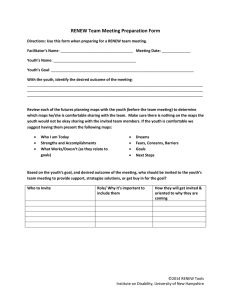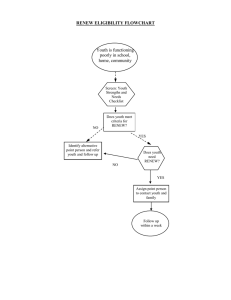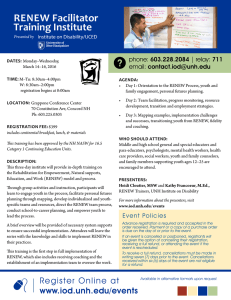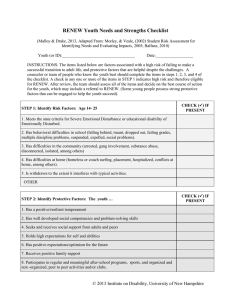RENEW Facilitator Training Day 1 JoAnne Malloy
advertisement
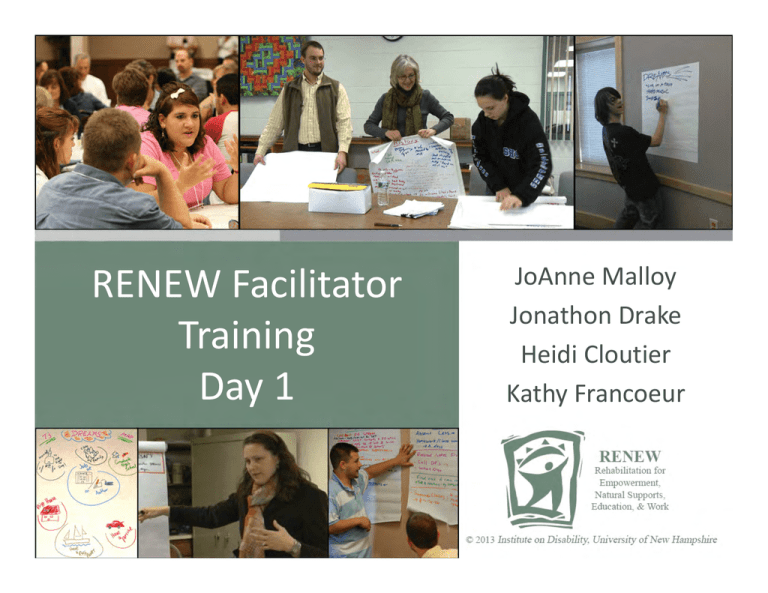
RENEW Facilitator Training Day 1 JoAnne Malloy Jonathon Drake Heidi Cloutier Kathy Francoeur renew.unh.edu © Institute on Disability, University of New Hampshire Acknowledgements • Doug Cheney, Professor of Special Education, University of Washington • Lucille Eber, Director, Midwest PBIS Network • Steve Goodman, Michigan's Integrated Behavior and Learning Support Initiative (MiBLSi) • Kelsey Carroll, Justin Tilbe, and Anthony Haley and many more youth, families, and collaborators! 2 renew.unh.edu © Institute on Disability, University of New Hampshire Agenda Day 1 • Orientation • RENEW: Practice Features • PHASE 1 – Personal Futures Planning – Practice & Skill Building • Reflections 3 renew.unh.edu © Institute on Disability, University of New Hampshire Learning Objectives • The logic and target population for the RENEW Model • How to engage youth using graphic facilitation • How to facilitate the RENEW mapping process renew.unh.edu © Institute on Disability, University of New Hampshire Our Norms Be Responsible Make sure you are comfortable & that your personal needs are met Address question/activity in group time before discussing “other” topics Address your attention to the topic and task Ask questions Be Respectful Be Prepared Turn cell phones, beepers, PDA’s, and pagers off or to vibrate/silent Be aware of the needs of your group Respect and consider every idea Contribute to activities and conversations Bring an open mind Follow through 5 renew.unh.edu © Institute on Disability, University of New Hampshire Activity STEP 1: Identify 1‐2 youth with significant emotional or behavior needs. Talk about: – Types of problems exhibited – Academic performance – Social/emotional characteristics – Issues outside of school Step 2: How does your school or agency respond to each of these young people now? 6 renew.unh.edu © Institute on Disability, University of New Hampshire Activity (cont.) Step 3: What should the school’s or agency’s response be? What would the ideal be? STEP 4: What is needed to reach the ideal? STEP 5: What are the gaps between what is needed and what exists? 7 renew.unh.edu © Institute on Disability, University of New Hampshire Poor Functioning • High rates of school dropout (with associated low income and employment) • High rates of anti‐social behavior including incarceration, arrests, behavior problems in school • High rates of trauma • Poor access to or utilization of mental health services • Lack community and social supports 8 renew.unh.edu © Institute on Disability, University of New Hampshire Disproportionality Suspensions and Expulsions Out of School Suspensions Students with Disabilities African American Males Students without Disabilities Caucasian Males The dropout rate is 50% or more among African Americans, Native Americans, Hispanic youth, and students with emotional challenges (Krezmien, Leone, & Achilles, 2006; Skiba, Michael, Nardo, & Peterson, 2002; U.S. Department of Education, 2003, 2012) 9 renew.unh.edu © Institute on Disability, University of New Hampshire Mental Health Needs of Youth • School is the “defacto” Mental Health provider • Juvenile Justice system is next level of system default • 1‐2% identified by schools as Emotional Behavioral Disabilities • Those identified have poor outcomes • Suicide is 4th leading cause of death among youth 10 renew.unh.edu © Institute on Disability, University of New Hampshire Mini‐Film: Tariq • What are your thoughts and reflections….. • What does Tariq say would have helped him when he was younger and in school? • What do kids need to do well in school, home, and community? 11 renew.unh.edu © Institute on Disability, University of New Hampshire What is needed for youth with Emotional, Behavioral Disorders/Challenges (EBD) Wagner & Davis (2006) recommend that programs for youth with EBD include: • Support to complete the school’s academic program • Assistance with high school completion and real world employment • Building self‐determination skills • Assistance to build a positive social support network • Assistance to develop a personalized career and post‐high school plan 12 renew.unh.edu © Institute on Disability, University of New Hampshire Early Contributors and Co‐Developers of RENEW • Doug Cheney, Professor of Special Education, University of Washington • Gail Cormier, Executive Director, North Carolina Families United • Patty Cotton, Person‐Centered Planning Consultant • David Hagner, Research Assistant Professor, UNH • Kathleen Abate, Granite State Federation of Families for Children’s Mental Health renew.unh.edu © Institute on Disability, University of New Hampshire RENEW History (Rehabilitation, Empowerment, Natural supports, Education and Work) • Developed in 1996: 3‐year RSA‐funded employment model demonstration project for youth with “SED” in Manchester NH – Initial promising results (Bullis & Cheney, 1999; Cheney, Malloy & Hagner, 1998; Malloy, Cheney, & Cormier, 1998 ) • 1998‐2007: Developed a non‐profit community based agency: provided RENEW to youth in New Hampshire • 2002‐Present: Provided to youth in high schools as the tertiary level intervention in a 3‐tiered PBIS model in NH, IL, PA, WI, and MA • Provided to youth as part of SOC projects in North Carolina • 2008‐Present: Provided by community mental health providers in New Hampshire – Focus is on community‐based, self‐determined services and supports 14 renew.unh.edu © Institute on Disability, University of New Hampshire 1996 Developed under a 3‐year, RSA‐funded employment model demonstration project for youth with “SED” in Manchester, NH 1998‐2007 Developed a non‐profit community based agency: provided RENEW to youth in New Hampshire: 1998‐2007 2002‐present Provided to youth in high schools as the tertiary level intervention in a 3‐tiered PBIS model NH, Il, PA, WI, MA Provided to youth as part of SOC projects in North Carolina 15 2008‐present Provided by community mental health providers in NH. Focus is on community‐ based, self‐ determined services and supports 2014 Provide international training, technical support, & coaching renew.unh.edu © Institute on Disability, University of New Hampshire RENEW Theory of Change Context: Youth who are: •Disengaged from home, school, and/or community •Involved in mental health, child welfare, and/or juvenile justice system •Experiencing failure in school, home, and/or community Facilitators Provide: 1. Personal futures planning, including choice‐making and problem‐solving. 2. Individualized team development and facilitation 3. Personally relevant school‐to‐career development, support, and progress monitoring. Shorter‐Term Improvements In: Self-determination Capacity & Opportunity Student engagement and self-efficacy Behavioral, Cognitive, & Affective Longer‐Term Improvements in: • Emotional & Behavioral Functioning • Educational Outcomes • Employment More effective formal and natural supports Source & Type 16 renew.unh.edu © Institute on Disability, University of New Hampshire RENEW within a PBIS Model • To address school‐based systems/climate issues: – Positive Behavioral Interventions and Supports (PBIS) (Bohanon, et al., 2004; Sugai & Horner, 1999) – Student Leadership • To address issues for students most at‐risk: – Rehabilitation for Empowerment, Natural supports, Education, and Work (RENEW) (Bullis & Cheney, 1999; Cheney, Malloy & Hagner,1998; Malloy, Sundar, Hagner, Pierias, Viet, 2010) 17 renew.unh.edu © Institute on Disability, University of New Hampshire The APEX High School Model: Positive Behavior Interventions and Support & RENEW (Malloy, Agorastou & Drake, 2009 Adapted from Illinois PBIS Network, Revised Sept., 2008 & T. Scott, 2004) Student Progress Tracker Individual Futures Plan Tier 3 RENEW and Wraparound Simple Individual Interventions Competing Behavior Pathway Functional Assessment Interview Weekly Progress Report (Behavior and Academic Goals) ODRs, Attendance, Tardies, Grades, Credits, Progress Reports, etc. Tier 2 (Brief FBA/BIP, Schedule/Curriculum Changes, etc) Small Group Interventions Tier 1/Universal School‐Wide Assessment School‐Wide Prevention Systems 18 (CICO, Social and Academic Support Groups, etc.) renew.unh.edu © Institute on Disability, University of New Hampshire RENEW Goals & Principles • RENEW Goals • RENEW Principles – High School Completion – Employment – Post‐Secondary Education – Community Inclusion – Self‐Determination – Unconditional Care – Strengths‐Based Supports – Flexible Resources – Natural Supports 19 renew.unh.edu © Institute on Disability, University of New Hampshire RENEW Strategies 1. 2. 3. 4. 5. 6. 7. 8. Personal Futures Planning Individualized Team Development & Facilitation Braided (individualized) Resource Development Flexible, or Alternative Education Programming Individualized School‐to‐Career Planning Naturally Supported Employment Mentoring Sustainable Community Connections 20 renew.unh.edu © Institute on Disability, University of New Hampshire RENEW 4‐Phase Process 21 renew.unh.edu © Institute on Disability, University of New Hampshire RENEW IS… • A flexible, person‐centered planning and support service • Driven by the student’s expressed needs, interests, and goals • Designed to foster competence by creating supported educational and career‐related experiences in which the youth can be successful • Designed to be flexible and individualized • Designed to build social resources for the youth RENEW IS NOT… • A program • A course, a classroom, or a school 22 renew.unh.edu © Institute on Disability, University of New Hampshire Customize/copy a case example here or Use Anthony Video renew.unh.edu © Institute on Disability, University of New Hampshire Anthony & RENEW “Renew gave me more structure and helped me focus on goals I could not do myself otherwise. I did not have to think for myself. I just could think about surviving.” renew.unh.edu © Institute on Disability, University of New Hampshire My Life before RENEW • Home – – – – Dad? Family? Mom? Basic Needs: food, shelter, health • School – Attended school regularly but could not concentrate – Behind in Credits – failed Fresh Experience, Wellness, lacked math credit – Skipping Class – why I failed most of classes – Attitude – disruptive in halls and classes – did not care about school – Suspended – ISS and OSS for fighting, disruption – Drugs – Had a few close friends that had a similar bad situation… renew.unh.edu © Institute on Disability, University of New Hampshire My Life Today • Stormy and unsettled household – dark cloud over our family • Uncertainty of food & shelter daily • Mother and boyfriend – lazy, drinking a lot • Stressed all the time • Life is hectic but remain hopeful • Over crowed household • Living out of storage bins • Personals stuff getting lost/stolen • Brother facing jail time • Missing deceased father 26 renew.unh.edu © Institute on Disability, University of New Hampshire My Strengths: Helped me realize how I can use my strengths to be successful in everyday life Strengths: • Reading books • Research interesting facts • Easygoing • Smart • Does not argue back • Friends Accomplishments: • Passing Classes • Honor roll • Maturing • Can live on very little • Appreciate what I have • Employed 27 renew.unh.edu © Institute on Disability, University of New Hampshire My Resources: The People in My Life People Help me establish a support system Inner: People whom I could trust and were readily available Middle: Important people in and out of school I could count on for advice Outer circle: Professionals & other resources Important 28 renew.unh.edu © Institute on Disability, University of New Hampshire My Preferences What Works: • Positive connection with teachers • Having time to study during the school day • Learning interesting facts & seeing the evidence • Daily reminders • Having directions explained in a non demanding way What doesn’t work: • Unreasonable teachers • Homework • The requirement of school 29 renew.unh.edu © Institute on Disability, University of New Hampshire Dream Helped me put my aspirations on paper so they are more believable and visual SHS Diploma College Shelter A car EMT A Pug renew.unh.edu © Institute on Disability, University of New Hampshire My Fears & Challenges Obstacles Helped me realize what his getting in the way of succeeding: • • • • • • • Time Tardies Unmeet Basic Needs Sleep Deprived Unemployed Depressed Unsure of Living Situation renew.unh.edu © Institute on Disability, University of New Hampshire My Goals and Next Steps •Find a way to stay in Somersworth •Help Mom find housing •Take care of my dog •Find a home and get pet supplies •Get Good Grades •Learn time management skills •Get help •Get to school on time •Work •to earn money •Help with basic needs •License •Get social security number •Get birth certificate •Proof of residency •Study Manual •Find someone to practice driving •Expand education •Apply for college •Complete FASA/scholarships •Get certified as an EMT renew.unh.edu © Institute on Disability, University of New Hampshire Anthony’s Action Plan for Transition: Goal: To explore military & college, obtain driver’s license ACTION STEPS PURPOSE or NEED WHO? WHEN? Obtain SS Card To be independent and open a bank account and get a job To get a job Anthony and Mom Chloe and Anthony Anthony & RENEW team Spring 2011 Obtain non driver’s license identification Meet with military recruiter To explore military options Spring 2011 Spring 2011 Meet with financial aid person at GBCC Take Accuplacer Test To develop a plan to pay for college Anthony Aug 2102 To plan course work for major Anthony Aug 2012 Complete FAFSA Find out about college costs Obtain Driver’s license Practice driving Review manual To be independent Anthony and FAFSA Fridays GBCC Ongoing Antony & Driving renew.unh.edu Instructor © Institute on Disability, University of New Hampshire 12 10 Office Discipline Data 10 9 RENEW began 8 6 6 4 3 2 2 0 0 1 2 3 4 5 6 Semester 34 renew.unh.edu © Institute on Disability, University of New Hampshire Credits Earned 5 4.5 4 3.5 3 2.5 2 1.5 1 RENEW began Concern: Not earning credits necessary for graduation 0.5 0 1 2 3 4 Semester 35 5 6 renew.unh.edu © Institute on Disability, University of New Hampshire Grade Point Average 2.5 2 1.5 1 0.5 Before RENEW RENEW 0 2008-2009 2009-2010 36 Anthony’s Team Standing (Core) Team: • Anthony • Mr. Storms, Welding Teacher & RENEW Facilitator • Mom • Guidance Counselor(s) • Administrator(s) • Mrs. Francoeur, NH RESPONDS facilitator • Mr. Quigley, mentor Rotating Members: • Teachers • Administrators • Food Pantry • Friends • Recruiters renew.unh.edu © Institute on Disability, University of New Hampshire How RENEW Impacted My Life • My team stays in touch with me ( Mr. Storms, Mrs. Francoeur) • Learned skills to develop self action plans • Check‐ins to see if there is anything my facilitators can help me add to the plan • I am my own advocate • Understand myself better • Think about problems in a more realistic and doable way • Use the resources around me effectively • Developed good job skills and work ethic renew.unh.edu © Institute on Disability, University of New Hampshire 39 renew.unh.edu © Institute on Disability, University of New Hampshire How RENEW Helped Me… • • • • • Maps Action Planning Rewards and celebrating successes Gave me structure Put goals in my life to work toward – Goals that I could not do myself, or could not dream of because I could only think about surviving 40 renew.unh.edu © Institute on Disability, University of New Hampshire Since Graduating RENEW • • • • • • License Wheels Living independently Held 3 jobs simultaneously Working part‐time as a Youth Mentor for UNH Have joined the Marines 41 renew.unh.edu © Institute on Disability, University of New Hampshire Discussion: Qualities of a RENEW Facilitator In a small group, discuss the some of the qualities and characteristics that are important to possess as a RENEW facilitator when working with youth and families. Refer to Handout # 1.1: RENEW Facilitator Characteristics Checklist renew.unh.edu © Institute on Disability, University of New Hampshire Break 43 renew.unh.edu © Institute on Disability, University of New Hampshire RENEW Phase One: Futures Planning *Manual Chapter 3 44 renew.unh.edu © Institute on Disability, University of New Hampshire RENEW Maps Start here • Use graphics and words • Use flip chart paper • Engaging for participants 45 renew.unh.edu © Institute on Disability, University of New Hampshire Mapping Elements • Futures Planning maps use flip chart paper and markers, a PowerPoint projected on a wall, or a Smart Board and should include: – Both words and graphics that represent the student and their story – A focal point where the youth can see the maps being created 46 renew.unh.edu © Institute on Disability, University of New Hampshire The Purpose of Futures Planning • Use “Maps” to create a meaningful, personalized, individualized plan • Identify supports at home, school, and in the community • Assist the youth to build self determination skills 47 renew.unh.edu © Institute on Disability, University of New Hampshire 3 Simultaneous Facilitation Skills Active Listening/ Capturing the speakers voice: • Being a conduit for discussion • Flow of words to paper, and then reflect back for understanding and accuracy Synthesizing & Organizing information: • Use of templates & maps to keep the information organized & efficient • Using colors to represent different approaches, moods, and meanings Drawing: • Symbols & graphics to convey theme, meaning, & keep interest 48 renew.unh.edu © Institute on Disability, University of New Hampshire Using Graphics 49 renew.unh.edu © Institute on Disability, University of New Hampshire Drawing Basic Graphics • • • • • • • • • Lines Shapes Star people Speech Process Place movement and environment Interactions Symbolic graphics and ideographs Templates TRY IT! 50 renew.unh.edu © Institute on Disability, University of New Hampshire Mapping: Try It! • Part 1: Map Overview & Modeling • Part 2: Pairs ‐ Facilitate a Map • Part 3: Provide Feedback: – What went well? What could be improved on? Use of open ended questions? Level of interest & enthusiasm? • Part 4: Switch Roles and Repeat Parts 2 & 3 Refer to Handout 1.2: RENEW MAPS Example 51 renew.unh.edu © Institute on Disability, University of New Hampshire Ready….Ground Rules Set… explain the Rules 52 renew.unh.edu © Institute on Disability, University of New Hampshire Go! Map # 1 History Map • Purpose: Learn about the events that have shaped the youth’s life and the important people who contributed to where they are today. 53 renew.unh.edu © Institute on Disability, University of New Hampshire History Map 54 renew.unh.edu © Institute on Disability, University of New Hampshire Questions for Facilitating a History Map • Start where you want, tell us your story…. • What have been some of the most important things that have happened to you? You can go back as far as you like. • When did each event happen? How old were you? • What was important about each event? Describe the situation more… • How did you feel? • What happened as a result of each event? • Who was important in each situation? Who was there? • What are some of the toughest things that have happened to you? • What are some of the favorite things you have done? • Where are the important places you have gone? • Are there any special times of the year or events you look forward to? • Is there anything else you would like to add? 55 renew.unh.edu © Institute on Disability, University of New Hampshire Map # 2: Who I Am Today • Purpose: Describe what the youth’s life is like today. 56 renew.unh.edu © Institute on Disability, University of New Hampshire Who I Am Today 57 renew.unh.edu © Institute on Disability, University of New Hampshire Questions to Help Facilitate the Who I Am Today Map • Describe what your life is like today. How are things going at home and at school? How is this different than before? • What do you do each day? • How do you feel most of the time? • What do you wish was different? • How do you describe yourself to others? How would your friends describe you? How would your family describe you? • What are some of your roles in life? (e.g., sister, junior in high school, excellent video gamer) 58 renew.unh.edu © Institute on Disability, University of New Hampshire Map # 3: Strength and Accomplishments • Purpose: This map helps youth think of what they are good at and what they are proud of. It begins to let them see themselves in a positive way. 59 renew.unh.edu © Institute on Disability, University of New Hampshire Strengths and Accomplishments 60 renew.unh.edu © Institute on Disability, University of New Hampshire Questions for Facilitating the Strengths and Accomplishments Map • What have you done that you are proud of? What skills did you use to accomplish what you did? • Name something that makes you feel good about yourself. Why does it make you feel good? • What do you do when you have time to yourself? • What are you most passionate about? • What do your friends say you are really good at? • Did you ever do something that other people thought was great? 61 renew.unh.edu © Institute on Disability, University of New Hampshire Map # 4: People and Resources Map • Purpose: Capture critical information about people who are important to the youth, who can be relied on to help, and people who are not helpful 62 renew.unh.edu © Institute on Disability, University of New Hampshire People Map 63 renew.unh.edu © Institute on Disability, University of New Hampshire Questions for Facilitating the People Map • Who are the most important people in your life? Who are you closest to? For example, if you needed help in the middle of the night who would you call? These are the people that you can really count on when you need help. • Who do you trust to be there for you no matter what? Who are the people you trust to share everything with? • Who are the people who you can go to for help with certain things? These are the people who will help you, but may not always be thought of as a resource. What is your relationship with them (e.g., family, counselor, employer, friend)? • Who are the people in your life who are not helpful? What is your relationship with them? What do you do with them? • Who can you go to for connections to certain things? What is your relationship with them? How are they important to you? What connections do they have? 64 renew.unh.edu © Institute on Disability, University of New Hampshire Lunch 65 renew.unh.edu © Institute on Disability, University of New Hampshire Map # 5: Preferences Map • Purpose: This map helps gather information about the situations where the youth feels successful and situations that contribute to their difficulties in the learning environment, in relationships, and with communication. 66 renew.unh.edu © Institute on Disability, University of New Hampshire Preferences Map 67 renew.unh.edu © Institute on Disability, University of New Hampshire Questions for Facilitating the Preferences Map(s) • • • • • • • • • • • What works for you? What are the situations where you are more successful? What type of help is better for you in school, at home, with your friends, or when you are in the community? What works when you are trying to learn something new? What are your best subjects in school and why? What do your teachers do that is helpful? What helps you connect with others? What makes you feel heard and understood? What makes you happy? How would I know if you were happy? What doesn’t work for you or prevents you from being your best? When do you have trouble learning or doing something new? What are some things that frustrate or irritate you? What makes you angry, frustrated, anxious, or bored? 68 renew.unh.edu © Institute on Disability, University of New Hampshire We Jump to the Future: Map # 6: Dreams Map • Purpose: This map gives youth a chance to think big about what they would like their future to look like. The sky is the limit! 69 renew.unh.edu © Institute on Disability, University of New Hampshire Dreams Map 70 renew.unh.edu © Institute on Disability, University of New Hampshire Questions for Facilitating the Dreams Map • Think ahead – it is 3, 4, 5 years from now and you are achieving your dreams. Everything is great and as you want it to be. What does your life look like? What are you doing every day and with whom? • What have you accomplished in your perfect dream? • What are some of the things you have? • Where are you living? • What kind of relationships do you have? • What do you do for a job? • What do you do for fun? • Where are some of the places you have been? 71 renew.unh.edu © Institute on Disability, University of New Hampshire Map # 7: Fears, Challenges, Barriers • Purpose: This map helps to surface some of the obstacles that may be preventing the youth from achieving his or her dreams. 72 renew.unh.edu © Institute on Disability, University of New Hampshire Fears, Challenges, Barriers 73 renew.unh.edu © Institute on Disability, University of New Hampshire Questions for Facilitating the Fears, Challenges, and Barriers Map • What kinds of things could prevent you from reaching your dreams? • What has gotten in the way in the past? • What do you worry may happen? • What do you NOT want to happen? 74 renew.unh.edu © Institute on Disability, University of New Hampshire Map # 8: Goals • Purpose: This map will helps the youth to identify concrete and measurable stepping stones towards his or her dreams. This map provides structure to move forward in achieving the youth’s dreams. 75 renew.unh.edu © Institute on Disability, University of New Hampshire Goals 76 renew.unh.edu © Institute on Disability, University of New Hampshire Question for Facilitating the Goals Map • Given your dream, what would you need to accomplish in the next year or two to work toward that dream and to avoid you fears and concerns? • Make a list and number each goal. Make sure you think about school, home, and the community. Be specific! • When do you want to achieve this goal? • How will you know when you have reached your goal? What will be different? 77 renew.unh.edu © Institute on Disability, University of New Hampshire Map # 9: Next Steps: Prioritize Goals and Develop a Personal Action Plan • Purpose: To brainstorm pathways to achieve a particular goal. To strategize what additional information and resources are needed before essential next steps can be taken. To teach the student how to move from broad to specific planning. 78 renew.unh.edu © Institute on Disability, University of New Hampshire Next Steps: Personal Action Plan 79 renew.unh.edu © Institute on Disability, University of New Hampshire Questions to Facilitate Planning and Next Steps • Taking one goal at a time: – Given some of your concerns, what do you need to do first to work toward this goal? – Who is/are the best person(s) to help with this next step? – What resources will your need? – Who do we need to invite to see your plan and get on board so that they can help you? (e.g., your parents or people you live with, a teacher, the principal, counselor, therapist, other relative, friend, a mentor) 80 renew.unh.edu © Institute on Disability, University of New Hampshire RECAP: RENEW Process Map 81 renew.unh.edu © Institute on Disability, University of New Hampshire How, when, where, who? • Context for mapping meetings: – A quiet, private space with no interruptions – Explain why you are doing what you are doing – About 45‐50 minutes per session – Mapping is with you, and one or two other people of the youth’s choosing – Working in this way is an important commitment 82 renew.unh.edu © Institute on Disability, University of New Hampshire Reflections on Mapping with Graphics • Think about the needs of youth with emotional and behavior disorders…. • How might the mapping process build engagement? Trust? Empowerment? 83 renew.unh.edu © Institute on Disability, University of New Hampshire Questions and Homework • Review chapters 1, 2, and 3 in the RENEW Manual. • Read chapter 4 in the RENEW Manual. • Rate yourself on the RENEW Facilitator Characteristics Checklist (handout) • Like our RENEW Facebook page: https://www.facebook.com/IOD.RENEW 84 renew.unh.edu © Institute on Disability, University of New Hampshire Youth Voices Video • renew.unh.edu – RENEW Youth Voices Video http://www.iod.unh.edu/Projects/renew/renew _main.aspx 85 renew.unh.edu © Institute on Disability, University of New Hampshire References • (U.S. Department of Education, 2005; Wagner, 1991; Wehman, 1996; Wagner & Cameto, 2004; Wagner, Kutash, Duchnowski, & Epstein, 2005) • (Chen, C‐C., Symons, F. J., & Reynolds, A. J. , 2011;Cullinan & Sabornie, 2004; Nelson, Benner, Lane, & Smith, 2004; NH, 2008; Sabornie, Cullinan, Osborne, & Brock, 2005). • (Kilpatrick, Ruggiero, Acierno, Saunders, Resnick, & Best, 2003; De Bellis, 2005; Zinzow, Ruggiero, Hanson, Smith, Saunders, & Kilpatrick, 2009) • (Gopalan, et al., 2010; Kataoka, Zhang, & Wells, 2002; McKay, et al., 2005; Walker & Gowan, 2010) • (Cullinan, & Sabornie, 2004; Lane, Carter, Pierson, & Glaeser, 2006) 86 renew.unh.edu © Institute on Disability, University of New Hampshire Congratulations – You Have Completed Day 1! 87 renew.unh.edu © Institute on Disability, University of New Hampshire
